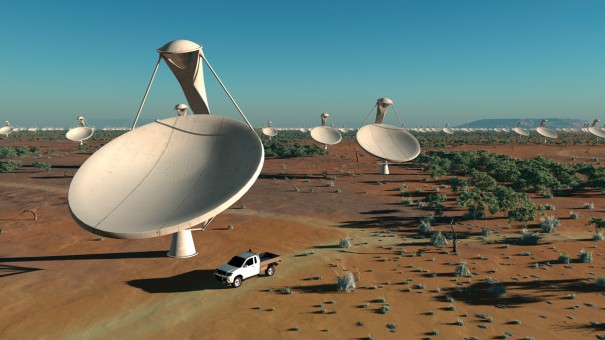
Artist's impression of dishes that will make up the SKA radio telescope. Image: Swinburne Astronomy Productions/SKA Program Development Office.
One of the best observatories in the Southern Hemisphere works night and day to provide us with a better understanding of the universe — and now it could be host to the SKA, the world’s largest radio telescope.
The Murchinson Radio-Astronomy Observatory (MRO), an area with low levels of radio frequency interference, is home to CSIRO’s Australian SKA Pathfinder (ASKAP), an array of antennas between 30MHz-3GHz that along with MeerKat (Southern Africa), the Murchinson Wide- field Array and the Low Frequency Array (LOFAR, Netherlands), is considered one of the precursors to the Square Kilometre Array (SKA).
Much has been said about the SKA, a 1.5 billion-euro project that will provide answers to pressing questions such as the cradle of life and the origin and evolution of cosmic magnetism. However, this project, fruit of global collaboration between 70 institutes in 20 countries, will change the way in which we perceive giant science projects.
Described as a “revolutionary radio telescope,” the SKA, instead of providing images of light waves, will “make pictures” from radio waves. To do so, the array will have 50 times more sensitivity and 10 thousand times the survey speed of the best telescopes now operating. These new images of the universe will give us a better understanding of the past and future of the universe. Nonetheless, as Brian Boyle, CSIRO SKA director suggests, “the most extraordinary thing that we will find is something that we haven’t thought of yet.” The SKA will find its home in 2012 — the bid is between Australia-New Zealand and South Africa. Once a location has been selected, construction will begin in 2016 and the first results will be available by 2024.
In April, 2011, the Fraunhofer Institute of Solar Energy, the Max Plank Institute for Radio Astronomy as well as CSIRO Astronomy and Space Science signed in Berlin, Germany, a Memorandum of Understanding that will help power the SKA and its pathfinders — including the ASKAP — in a sustainable way. According to Boyle: “We are trying to reduce the expense and maximise the development of the telescope by operating it as much as possible with renewable energy, our goal will be to operate it with 100 per cent renewable energy, but to do that we have to work with the people who are currently at the leading edge of research.” The Murchinson Radio-Astronomy Observatory will also benefit from this agreement — by 2020 its operations might rely on green energy.
While researchers and scientist worldwide wait for the final answer, Australia continues its path towards becoming the leader in radioastronomy and astrophysics.
http://www.youtube.com/watch?v=S21V9UfXDvg
This article was published in the July/August 2011 issue of Science Illustrated. If you want more information about the SKA, click here.






